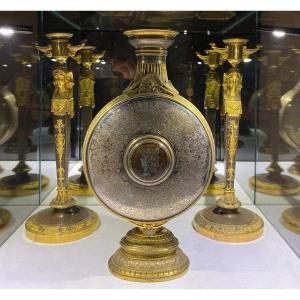Pair of bronze medallions depicting gallant scenes in ancient times.
Very nice foundry work
Chisel-gilder-founder. Hired as a chaser by Launay, after his ouster, he directed the last works on the Vendôme column with Amélie Gonon and the carpenter Ravenet. It melts without talent, in the sand, the Desaix de Dejoux. Founder Rémond was never named, in the documents we consulted, except by his last name without further details. We think it is probably François Rémond, officially chaser-gilder from a line of foundry-chasers already established under the Ancien Régime. Rémond had previously melted for Denon the Colossal Hermes Bust for the tympanum of the Louvre museum, Bartolini model, cast in 1805, and he had appraised the fonts of Gonon and Canlers for Denon. The disastrous result of its Desaix de Dejoux sand cast will give arguments to protesters for a long time. François Rémond or Raimond (1745 or 1747-1812, master in 1774) who exercised his activity at least from 1778 to 1803, seems to have been one of the most important master gilders-carvers in Paris. Its turnover amounted to 161,000 tournament pounds in 1784, and the merchant-mercer Daguerre alone paid him the sum of 275,000 tournament pounds for the years 1786-1788. His activity was twofold: on the one hand, he supplied raw materials and days of journeymen to a foundry which sold him cast iron; on the other hand he made transform this cast iron and he marketed the pieces thus worked and transformed either semi-finished, or gilded and chiseled in his own workshops. Among its regular customers Daguerre are the cabinetmakers Roetgen, Riesner, Frost, the goldsmith Clément, the chaser Gouthière, the watchmakers Lepaute and Lépine. He worked, no doubt on Bélanger models, for the Count of Artois (works at Bagatelle and at the Palace of the Temple) and for Baudard de Sainte-James; also for the architects Cellerier and Ledoux, and for Thélusson, client of the latter. Among his important clients, we also note the Prince of Soubise, the Dukes of Orleans, Laval and Penthièvre, the Duchess of Lauzun, the Marquise de Nicolaÿ, the Intendant of Cypierre and the financier Paris de Montmartel. The account registers make it possible to follow its activity for thirty years; they are a wealth of information for art historians who can spot his works there.
O






































 Le Magazine de PROANTIC
Le Magazine de PROANTIC TRÉSORS Magazine
TRÉSORS Magazine Rivista Artiquariato
Rivista Artiquariato